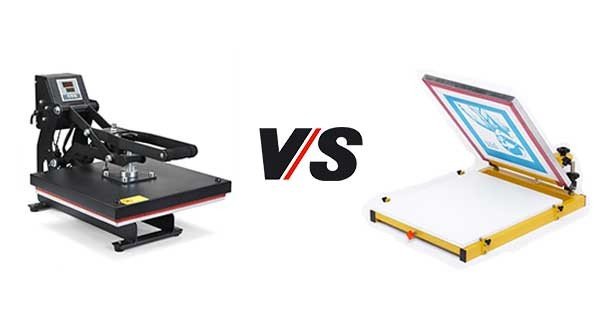
Screen Printing vs Heat Press
Mass producing shirts has become a lot easier thanks to recent innovations. These days, it’s possible to print hundreds or even thousands of shirts in a relatively short time.
The advent of methods, like screen printing and heat press, has made t-shirt printing more efficient than ever. These are some of the usual printing services you’ll happen upon while visiting websites of t-shirt sellers.
While both these printing solutions can make your shirts look cool and appealing, that doesn’t mean they’re created equal. In that sense, which do you think is the better method?
The Best Solution for Your T-Shirt Printing Project
It’s important to know which one between screen printing and heat press is fit for the project you’re about to engage in. For this, you will need to assess the purpose of the project and the goals you want to achieve with your shirts.

Screen Printing
Screen printing basically works by applying an ink-blocking stencil onto a nylon screen. The stencil contains ink that’s in liquid form.
What you’re going to do is take that stencil and transfer it to the garments to create your printed shirt.
Screen printing has its limits when it comes to designs because the method requires more equipment and chemicals to work properly. This is usually a go-to for many apparel companies.
Here are some of the items needed for screen printing to be effective:
- Printers
- Scrubbers
- Screens
- Films
- Tape
- Squeegees
- Plastisol ink
Screen printing is ideal for large-scale projects that require at least a thousand prints. Unlike other methods of printing, it doesn’t pose any limitations in terms of the number of shirts that need to be printed on. Furthermore, this method is known for producing a softer-feel and brighter print that’s durable and machine-washable.
If you’re handling small orders or are simply printing shirts for your friends and family, screen printing is not a process that’s recommended. It just costs too much money and takes too much work to complete that the end result (no matter how great) really isn’t worth it.
Moreover, screen printing doesn’t really allow you to take on multi-colored designs. In a lot of cases, you’re only able to work with one or two colors and take only a single color per screen. While it’s not impossible to print a multi-colored design using this method, you would need one screen for each of the design’s colors. That means 25 screens for a design that has 25 colors!
Heat Press
To say that the heat press is one of the “latest innovations” in printing is simply an understatement. Instead, it’s a revolutionary method that has made printing more universal.
Using a heat transfer machine, all one needs to do is press the design into the fabric and voila! You have your shirt!
Before the heat press machine comes into play, you’ll need to create your designs on a sheet of paper. The piece is then transferred to the garment using the heat press. With this machine, you can create intricate designs for your table cloths.

You’re also able to explore other designs using the following heat transfer procedures:
1. Vinyl Heat Transfer
This process involves cutting small designs and then transferring them onto the shirt using a heat press machine. With the heat press, you’ll easily be able to produce designs in large numbers.
Furthermore, unlike screen printing, this method of heat transfer allows you to use complex colors. If you’re looking to create multi-colored shirts and jerseys, this method has more than got you covered.
The vinyl heat transfer also prints garments that are durable and long-lasting.
2. Digital Print Heat Transfer
The process starts by printing the design onto a special transfer paper with the use of solvent ink. There are a lot of companies these days making use of this type of ink to create their shirts.
The digital print heat transfer method results in printed garments that are of impeccable quality, with images that have very high resolution. What’s more, this process only takes about three minutes to complete!
If you’re going to be dealing with complex colors, heat transfer should definitely be your method of choice. It’s a simple method that doesn’t make use of too many chemical combinations (that could be dangerous to your health in the long run). It also produces high-quality garments, thanks to its advanced software packages and specialized ink.
Final Thoughts
Both screen printing and heat press methods have taken t-shirt printing and design to new heights. However, at the end of the day, each has its advantages and disadvantages depending on your needs.
Figure out your purpose for printing t-shirts. If you intend to mass-produce for business, then go for screen printing. On the other hand, if you’re looking to print multi-colored designs for a small group of people, then opt for either of the two heat press transfer methods we’ve introduced to you today. Both these processes are more environment-friendly and can usually be done in the comfort of home.




